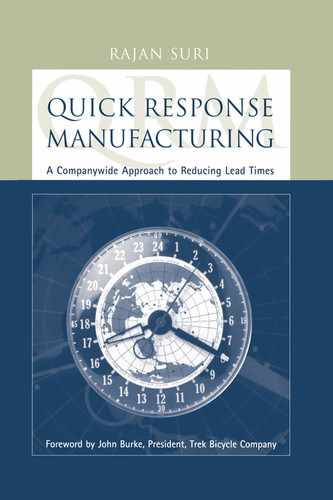Contents
Part One: A New Way of Thinking Stems from One Principle
Chapter One: QRM: Not Just Another Buzzword
How QRM Differs from Other Continuous Improvement and Quality Programs
Implementing QRM: What Managers Believe
Perceptions of Implementing QRM in North American Companies
Implementing QRM—The Prerequisites for Success
Improvement for the Entire Organization Comes from a Single Theme
Benefits of Quick Response in Product Introduction
Benefits of Quick Response in Existing Production
Waste Due to Long Lead Times and Late Deliveries
Results of Quick Response Strategies
Benefits of Quick Response in Securing Orders
Benefits of QRM: Forewarned Is Forearmed
Chapter Three: The Response Time Spiral—Legacy of the Scale and Cost Management Strategies
The Eras of Scale and Cost Strategies
The Response Time Spiral for Three Different Manufacturing Environments
Other Policies That Promote the Response Time Spiral
Roots of the Response Time Spiral
Eliminating the Response Time Spiral
Part Two: Rethinking Production and Materials Management
Chapter Four: Reorganizing Production
Seven Key Principles for Restructuring Your Company
The Manufacturing Cell-Creating the Product-Focused Organization
Staffing and Training Cell Workers
Planning, Scheduling, and Control with Cells
Cells Foster Continuous Improvement
Chapter Five: Structured Methodology for Implementing Cellular Manufacturing
Seven Steps to Successfully Implement Cells
Cellular Manufacturing Implementation Concerns—How to Overcome Them
Costing and Justification of Cells
Chapter Six: Creative Rethinking for Cellular Manufacturing
Challenge Conventional Choices
Use Technology That Enables a Smaller-Scale Process Implementation
Change the Sequence of Operations
Ask, Will the Operation Still Be Required?
Use Time-Slicing at the Shared Resource
Implement Time-Sliced Virtual Cells
Make the Resource Facility Behave Like a Subcontractor
Chapter Seven: Capacity and Lot-Sizing Decisions
Do You Have Good Intuition About Manufacturing System Behavior?
A Basic Formula for Lead Time for the Single Work Center
Effect of Utilization on Lead Time for the Work Center
Impact of Setup Reduction on Lead Time
Lot Sizing with Multiple Products
Products Requiring Multiple Operations
Additional Strategies Based on System Dynamics
Chapter Eight: Material and Production Planning in the QRM Enterprise
Pitfalls of On-Time Delivery Measures
MRP: A Collection of Worst-Case Scenarios
Align MRP Structure with QRM Strategy
Using Lead Time Reduction to Continuously Improve Your Processes
Chapter Nine: POLCA—The New Material Control and Replenishment System for QRM
Review of Push and Pull Systems
Key Concepts of JIT (Lean Manufacturing) Compared with QRM
Misconceptions Regarding the Pull System
Expanding Beyond JIT Strategies—A Tale of Three Companies
Summary of Disadvantages of Pull or Flow Methods for QRM
Material Control-Don’t Push or Pull, POLCA
Three Ds for Success of POLCA: Design, Discipline, and Decentralization
Chapter Ten: Customer and Supplier Relations
Supplier Relations—Another Response Time Spiral at Work
The QRM Approach to Supplier Relations
Customer Relations-Another Response Time Spiral at Work
Your QRM Program Can Support Your Marketing Efforts
Apply QRM Strategies to the Entire Supply Chain
Part Three: Rethinking Office Operations
Chapter Eleven: Principles of Quick Response for Office Operations
Office Operations: A Neglected Opportunity
The Response Time Spiral for Office Operations
Organizational Principles Required in the Office
Chapter Twelve: Tools to Support Q-ROC Implementation
Information Handling Principles
Tools to Assist in Q-ROC Implementation
Concerns with Implementing Office Cells
Chapter Thirteen: System Dynamics Principles for Quick Response
Strategically Plan for Idle Capacity
Replace Traditional Efficiency Measures
Convert Tasks from Sequential to Parallel
Reduce Task Setup Times and Minimize Batching
Use Capacity Management and Input Control
Create a Flexible Organization
Part Four: QRM for Rapid New Product Introduction
Chapter Fourteen: Extending Quick Response to New Product Introduction
Concurrent Engineering for NPI
Management Principles for Accelerating NPI
Design and Manufacturing Principles
Organizational and System Dynamics Principles Applied to NPI
Rapid NPI and Your Company’s Future
Part Five: Creating the QRM Enterprise
Chapter Fifteen: Management Mind-Set to Support QRM
Capacity and Facilities Decisions
Organizational Structure and Personnel Decisions
Production Planning and Scheduling Decisions
Supplier and Customer Decisions
Chapter Sixteen: Organizational Structure, Performance Measurement and Cost Systems
Drawbacks of Traditional Measures
New Measure of Performance—Introducing the QRM Number
Key Issues in Measuring Lead Time
Guidelines for Successful QRM Teams
Adjusting the Accounting System for QRM
Epilogue: Democracy in America (Revisited)
Chapter Seventeen: Steps to Successful Implementation of a QRM Program
Fifteen Specific Steps to Implementing QRM
